 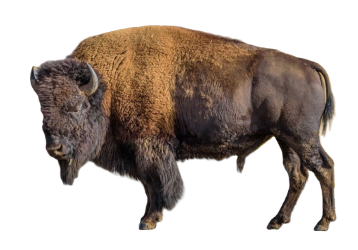 The American bison (Bison bison) is the largest land animal in North America. Bison can stand up to 1.8 metres tall. A male can weigh 900 kilograms, and a female 400.
The American bison (Bison bison) is the largest land animal in North America. Bison can stand up to 1.8 metres tall. A male can weigh 900 kilograms, and a female 400.Bison are easy to identify. A noticeable characteristic is the hump on their shoulders. Another is their deep brown fur, which can grow very long. Bison also grow a long beard and mane. The head is very large, with a thick skull. Bison fight by crashing their heads or horns together. Both male and female bison have short, curved, black horns, which can grow to half a metre long. The American bison was called "bufello" by early American settlers due to some similarities between it and known buffalo species. The words "bison" and "buffalo" are often used interchangeably, but the bison and the buffalo are completely different animals. The American bison (Bison bison) and the two main species of buffalo live on different continents. The African or cape buffalo (Syncerus caffer) and the wild Asian water buffalo (Babalus arnee) are only distant relatives of the American bison. Bison once ranged over much of North America, including central Canada and most of the interior United States. It's estimated that as many as 100 million bison roamed the Great Plains before 1800. Many were slaughtered by the U.S. government in an organized effort to destroy the livelihood of Plains Indians. By the 1980s, fewer than 1,000 remained.  Though the American bison population has since recovered, the species is still considered threatened, and the remaining bison depend on conservation efforts for survival. About 30,000 American bison survive wild in conservation herds.
Though the American bison population has since recovered, the species is still considered threatened, and the remaining bison depend on conservation efforts for survival. About 30,000 American bison survive wild in conservation herds. (There are two bison subspecies, the plains bison and the wood bison; 20,000 are plains bison and 10,000 wood bison). Another approximately 500,000 individuals are managed commercially as livestock. Today bison are only wild in national parks, state parks, and reserves. American bison like open plains, savannas, and grasslands. American bison are herbivores. They like low growing grasses and sedges, and are constantly on the move, traveling in groups, and even walking while they eat. Herds are usually divided by sex, with females and calves in one herd and males in another. When the summer breeding season begins, males may join the female herd looking for a mate. The dominant bulls (male bison) choose a female and defend her against other males. The males butt heads or use their horns. Once the female agrees to mate, the pair mates several times. 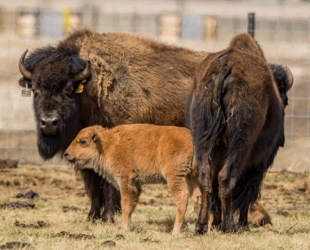 The cows (female bison) are pregnant throughout the fall, winter, and into spring. Calves are born in mid-spring; most cows only have one offspring. Each calf weighs about 23 kilograms and has reddish fur. Within an hour after birth the calf stands and, soon after, begins to walk. The cows (female bison) are pregnant throughout the fall, winter, and into spring. Calves are born in mid-spring; most cows only have one offspring. Each calf weighs about 23 kilograms and has reddish fur. Within an hour after birth the calf stands and, soon after, begins to walk. The cows will care for their young for about a year. Before they're a year old, juvenile bison are feeding on their own and have the brown fur of the adults. 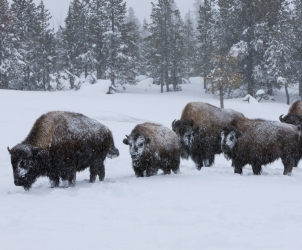 The cold and lack of food in winter can be hard on bison, especially the young and old, and the injured. Bison will sweep their large heads from side to side like a plow to clear away snow to find food. Very young bison have the highest risk of dying over the winter. Bison that survive to adulthood, however, can live around 20 years. The cold and lack of food in winter can be hard on bison, especially the young and old, and the injured. Bison will sweep their large heads from side to side like a plow to clear away snow to find food. Very young bison have the highest risk of dying over the winter. Bison that survive to adulthood, however, can live around 20 years. Despite their immense size, bison still have to worry about predators. Buffalo calves can easily become the prey of a wolf pack or grizzly bear. 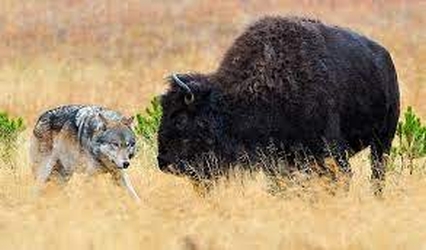 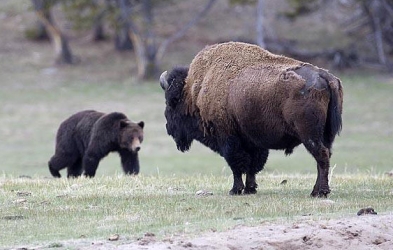 |